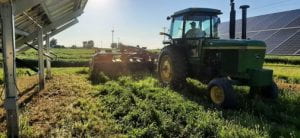Tim Barnes, OSU Extension Educator ANR, Marion County
In honor  of the opening day at the Ohio State Fair, we are featuring a piece that was originally highlighted in 2019 by one of our very own team members, Tim Barnes. Whether you attend the state fair or not, it’s importance in the Ohio sheep industry has made a long lasting impact for all shepherds alike. Enjoy!
of the opening day at the Ohio State Fair, we are featuring a piece that was originally highlighted in 2019 by one of our very own team members, Tim Barnes. Whether you attend the state fair or not, it’s importance in the Ohio sheep industry has made a long lasting impact for all shepherds alike. Enjoy!
I realize that there may not be broad-based interest in this article but the impact of this fair is tremendous for many people in the Ohio sheep industry.
A History of the Ohio State Fair
The first Ohio State Fair was held on the site of Camp Washington about two and a half miles from what was then the center of Cincinnati, on the Miami Canal. The listings of premiums and regulations for the first annual Fair shows the dates for this event to be the 11th, 12th and 13th of September 1850, however, it was postponed until the first week in October.
An Agricultural convention was held in Columbus, June 25 and 26, 1845 in which friends of Agriculture from all sections of the State participated. One of the results of this gathering was the organization of a Board of Agriculture whose object was to encourage, promote and aid an exhibition of farm products at county and district gatherings. This was largely due to the influence of M. B. Bateham, Michael L. Sullivant, and Samuel Medary of Columbus and Franklin County.
The Ohio legislature passed an act Continue reading History of The Ohio State Fair

 early dry weather allowed most of us to get our first cutting hay in a timely manner, and now we are into second-cutting hay. This is the time of the year that I like to remind everyone that it is a great time to assess if you have enough hay for the winter, as well as to consider if there are other things that can be done to assure adequate feed for livestock this winter.
early dry weather allowed most of us to get our first cutting hay in a timely manner, and now we are into second-cutting hay. This is the time of the year that I like to remind everyone that it is a great time to assess if you have enough hay for the winter, as well as to consider if there are other things that can be done to assure adequate feed for livestock this winter. forages planted in late summer can be sources of highly digestible fiber in ruminant livestock rations. There are several excellent forage options that can be considered for no-till or conventional tillage plantings in the late summer or early fall planting window. These forages can be a planned component of the overall forage production plan. They can be utilized on land that would otherwise sit idle until next spring, such as following wheat or an early corn silage harvest.
forages planted in late summer can be sources of highly digestible fiber in ruminant livestock rations. There are several excellent forage options that can be considered for no-till or conventional tillage plantings in the late summer or early fall planting window. These forages can be a planned component of the overall forage production plan. They can be utilized on land that would otherwise sit idle until next spring, such as following wheat or an early corn silage harvest. Midwest has seen an increase in photovoltaic (PV) solar energy production over the past several years. Nowhere is this more evident than in Ohio. Traditional ground cover options for utility-scale solar projects includes stone, gravel, bare earth, and various types of turfgrass vegetation. However, as the buildout of utility-scale solar projects increases, many are exploring the feasibility of dual land-use strategies that incorporate agricultural and conservation practices with solar production. Popular examples include pairing solar production with specialty vegetable crop production, livestock grazing, and pollinator habitats. However, as the size of utility-scale projects in Ohio has evolved from 100- to 200-acre projects into projects that are 2,000 acres or more, widespread integration of these practices faces real, common challenges:
Midwest has seen an increase in photovoltaic (PV) solar energy production over the past several years. Nowhere is this more evident than in Ohio. Traditional ground cover options for utility-scale solar projects includes stone, gravel, bare earth, and various types of turfgrass vegetation. However, as the buildout of utility-scale solar projects increases, many are exploring the feasibility of dual land-use strategies that incorporate agricultural and conservation practices with solar production. Popular examples include pairing solar production with specialty vegetable crop production, livestock grazing, and pollinator habitats. However, as the size of utility-scale projects in Ohio has evolved from 100- to 200-acre projects into projects that are 2,000 acres or more, widespread integration of these practices faces real, common challenges: